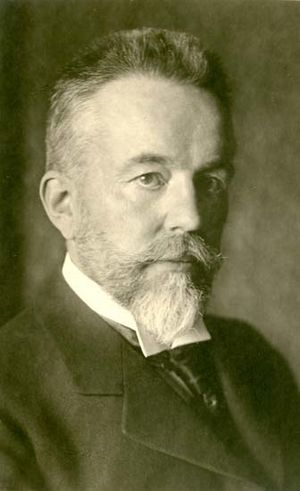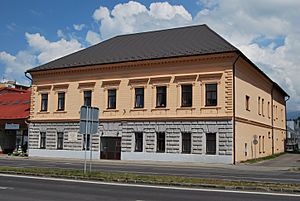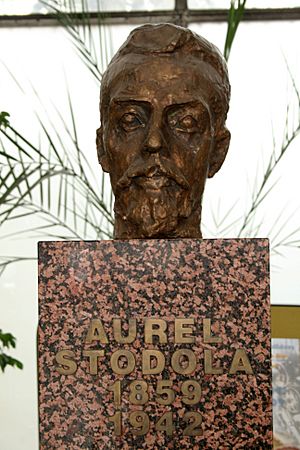Aurel Stodola facts for kids
Quick facts for kids
Aurel Stodola
|
|
|---|---|
 |
|
| Born | 10 May 1859 |
| Died | 25 December 1942 (aged 83) Zürich, Switzerland
|
| Resting place | Liptovský Mikuláš, Slovakia |
| Education | Budapest University of Technology and Economics |
| Known for | Centrifugal compressor Steam turbine Stodola's cone law Gouy-Stodola theorem |
| Awards |
|
Aurel Boleslav Stodola (born May 10, 1859 – died December 25, 1942) was a brilliant Slovak engineer, physicist, and inventor. He was a pioneer in understanding how heat and energy work in machines. He is best known for his important work on steam and gas turbines. These powerful machines help generate electricity and power many things we use every day. Stodola also taught mechanical engineering at the Swiss Polytechnical Institute in Zurich. He even knew famous people like Albert Einstein!
Contents
Aurel Stodola's Life Story
Aurel Stodola was born on May 11, 1859. His birthplace was Vrbica-Hušták, which is now part of Liptovský Mikuláš in Slovakia. At that time, it was part of the Kingdom of Hungary. His father, Ondrej Stodola, made leather goods. His mother was Anna Kováčová. He was named Aurel Bohuslav, but he mostly used the name Aurel. A famous Slovak leader, Michal Miloslav Hodža, baptized him.
His Education Journey
Aurel went to primary school in Vrbica, his hometown. After four years, he moved to Stráže pod Tatrami (now Poprad). He went there to improve his German language skills. It was common for students to do this because many German speakers lived there. He then attended secondary schools in Levoča, Kežmarok, and Košice. He also studied a lot on his own, especially classic books and other languages.
In 1876, he started studying at the Royal Joseph University in Budapest. He was a very talented student and received a scholarship. Later that year, he moved to the Eidgenössische Polytechnische Schule in Switzerland. Today, this school is known as ETH Zurich. In 1881, he earned his degree in Mechanical Engineering.
After graduating, he worked in a factory in Budapest for seven months. In 1882 and 1883, he studied at the TH Charlottenburg in Berlin. He also volunteered at a technical studio in Paris to improve his skills and learn French. This was important for his future career in Switzerland. After his time in Paris, he became an engineer in Prague. He quickly became a lead engineer, gaining valuable practical experience.
Working in Zürich
In 1892, Aurel Stodola became a Professor of Machine Construction at the Polytechnikum in Zürich. He taught and worked there until he retired in 1929. His first lecture was on October 23, 1892. Stodola helped improve the school's courses. He also helped build the first machine laboratory, which opened in 1900. This lab is now called the Laboratory for Energy Conversion. In the same year, he was asked to be an expert judge at a big exhibition in Paris.
He became a Swiss citizen in 1905. In 1924, he started a foundation to support mechanical and electrical science at ETH Zurich. This foundation still helps students and researchers today.
Stodola was friends with many smart people, both in Switzerland and other countries. One of his famous friends was Albert Einstein. Einstein even wrote a special letter to Stodola for his anniversary. Another important friend was Albert Schweitzer, a doctor and philosopher. Stodola encouraged Swiss business people to support Schweitzer's hospital in Africa.
Stodola retired at age 70, but he didn't stop working. He continued to be an expert and advisor. He was also very interested in physics and philosophy. In 1931, he wrote a book about how engineers see the world. It talked about social, political, and technology issues of his time. This book was printed many times and helped shape ideas about technology in Europe.
In 1939, Stodola led a team at Brown Boveri. They did the first test in the world using a gas turbine to make electricity. This amazing machine is still on display today. It is seen as a huge step forward in mechanical engineering history. Aurel Stodola passed away on December 25, 1942, in Zurich. His body was later moved back to his birthplace in Slovakia in 1989.
Amazing Work with Turbines
In 1903, Aurel Stodola published his most important textbook, Die Dampfturbine (The Steam Turbine). This book was translated into many languages. It became a key guide for building thermal turbo-machines. These machines use heat to create power.
Stodola also developed something called the "Law of the Ellipse," or Stodola's cone law. This law helps engineers calculate how pressure changes inside a turbine. It is very useful for understanding how turbines work in different situations.
His book, Steam and Gas Turbines, was very important. A Soviet rocket scientist named Fridrikh Tsander used it in the 1920s. It was also a basic reference for engineers in the United States. They used it when they were developing the first jet engines. Stodola worked closely with companies to develop the first useful gas turbines. One of these companies was Brown, Boveri & Cie. They built the first gas turbine-powered electric generator in 1939.
Helping with Medical Equipment
From 1915 to 1916, Stodola worked with a German surgeon named Ferdinand Sauerbruch. They teamed up to create an advanced prosthetic arm that could move mechanically. This was one of the first times a surgeon and an engineer worked together so closely. Sauerbruch believed that doctors, scientists, and engineers should always work as a team.
Honors and Awards
Aurel Stodola received many awards and honors for his contributions:
- 1905 – He received an honorary degree from Leibniz University Hannover.
- 1908 – He was awarded the Grashof medal from the Verein Deutscher Ingenieure.
- He received an honorary degree from the German Technical University in Brno.
- 1929 – He received an honorary degree from Charles University in Prague.
- 1941 – He was awarded the James Watt International Medal.
He was also a corresponding member of the French Academy of Sciences.
See Also
 In Spanish: Aurel Stodola para niños
In Spanish: Aurel Stodola para niños
- Heat pump
- Timeline of jet power






